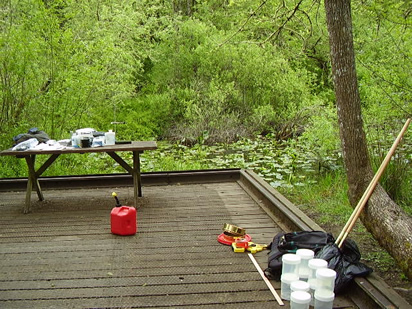
THE XERCES SOCIETY FOR INVERTEBRATE CONSERVATION Aquatic Invertebrates in Pacific Northwest Freshwater Wetlands |
| Home |
General considerations for designing a wetland invertebrate study General considerations for designing a wetland invertebrate study 1) Define your question and your objectives, then determine the best way to answer your question. Think about the different stressors that may be affecting your wetland. For example, is there eutrophication from excess nitrogen or phosphorus fertilizer runoff? Does most of the water run into the wetland directly off of roads or other impervious surfaces? Has the hydrology been altered by levees or drainage ditches? 2) Investigate the scientific literature to find out what is already known about your question. For example, has a study of wetland invertebrates already been done in your watershed? Has anyone established standard tolerance levels for certain wetland taxa in your state? If so, you may be able to build upon what is already known. You may want to talk with local specialists who may have answers to some of your questions, and to collect literature about wetland invertebrates that exist in your area. 3) Develop your methods for sampling and analyzing your results. You may be able to look in the scientific literature and find examples of methods that have worked for other people who have done similar studies (literature resources on study design). In a recent Xerces Society wetland invertebrate study, we based our methods on those developed by The Minnesota Pollution Control Agency (outside link). Link to resources on wetland invertebrate monitoring in other parts of the country. Download the Quality Assurance Project Plan (QAPP) from a recent Xerces Society study: Pacific Northwest Wetland Macroinvertebrate Monitoring: Protocols and Variability in Freshwater Riverine Impounding Wetlands, February 20, 2007 (pdf, ~23 MB) 4) Choose your sample sites and visit them before sampling begins. This is a good time to talk with land owners or managers and find out about the wetland you will be sampling. For example, is it perennial, or does it dry out? If it dries out, when is it completely dry? Be sure to find out what permissions you may need to access a desired sampling site. Link to a page on sampling aquatic invertebrates to read about things you may want to consider before heading out to the field. |
© 2007 Xerces Society
Contact info@xerces.org
